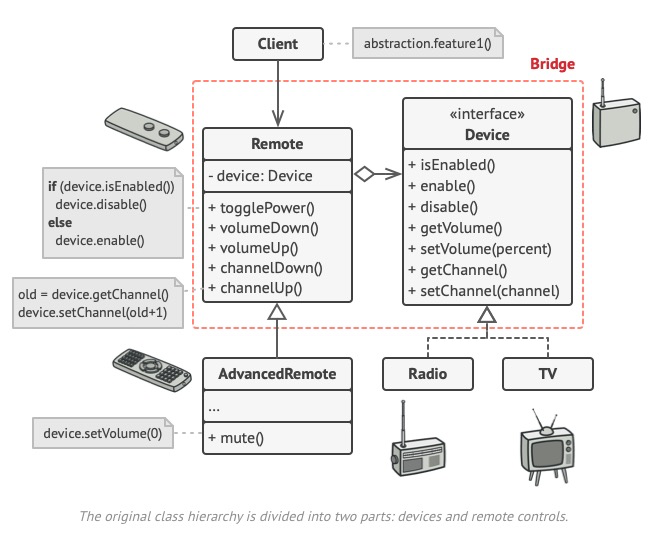简介
桥接模式可将一系列紧密相关的、水平等级的类,转变为组合关系,形成垂直等级关系。
如抽象类 Color、Shape,分别有 RedColor、BlueColor、CircleShape、SquareShape 的实现类,那么想创建红色方形,则可以将 Shape 类中持有 Color 引用,动态向 Shape 中注入 Color 实现即可。
否则分别实现 RedCircleShape、RedSquareShape、BlueCircleShape、BlueCircleShape 的话,假如再新增一个维度,实现类则需要修改,并新增很多实例。
桥接更直接的说就是组件化,模块化,让 A 中持有 B 的引用,B 可以随意调换,形成不同组合。
类图
角色
抽象实体 A
A 中包含实体 B 的引用
A 的具体实现
抽象实体 B
B 的具体实现
类图
图中的 Remote 和 Device 中间,就是桥接。Remote 内部持有一个 Device 的引用:device。通过 set 不同的 device,实现 Remote 与 Device 的不同组合。
类图
代码
class Abstraction{ protected $implementation;
public function __construct(Implementation $implementation) { $this->implementation = $implementation; }
public function operation(): string { return "Abstraction: Base operation with:\n" . $this->implementation->operationImplementation(); }}
class ExtendedAbstraction extends Abstraction{ public function operation(): string { return "ExtendedAbstraction: Extended operation with:\n" . $this->implementation->operationImplementation(); }}
interface Implementation{ public function operationImplementation(): string;}
class ConcreteImplementationA implements Implementation{ public function operationImplementation(): string { return "ConcreteImplementationA: Here's the result on the platform A.\n"; }}
class ConcreteImplementationB implements Implementation{ public function operationImplementation(): string { return "ConcreteImplementationB: Here's the result on the platform B.\n"; }}
function clientCode(Abstraction $abstraction){ echo $abstraction->operation();}
$implementation = new ConcreteImplementationA();$abstraction = new Abstraction($implementation);clientCode($abstraction);
$implementation = new ConcreteImplementationB();$abstraction = new ExtendedAbstraction($implementation);clientCode($abstraction);
复制代码
output:
Abstraction: Base operation with:ConcreteImplementationA: Here's the result on the platform A.ExtendedAbstraction: Extended operation with:ConcreteImplementationB: Here's the result on the platform B.
复制代码













评论